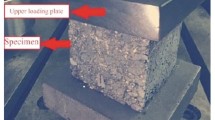Abstract
The objective of this study is to theoretically and experimentally characterize the internal structure in hot mix asphalt (HMA) mixtures. This is important to evaluate how the internal structures made of four different percentages of flat and elongated (F&E) aggregate change HMA's enginering properties in terms of rut depth, particle movement and orientation, and strain. A micromechanical model is developed to explain the behavior of the internal structure in an HMA mix. The experimental procedure relies on capturing images of the surface of an HMA specimen subject to wheel loading. The results demonstrate that the internal structure adjusts itself in the primary zone, reaches a preferred position in the secondary, but becomes stabilized in the tertiary zone. Low percentages of F&E aggregates result in a stable internal structure that could develop stone-on-stone contact and provide a better interlocking mechanism. The strain distribution within an HMA mix is influenced by particle configuration and mastic behavior, and is very localized.
Résumé
L'objectif de cette étude est de caractériser de manière théorique, et expérimentale la structure interne des mélanges HMA (Hot Mix Asphalt=bétons bitumeux). Ceci est important pour évaluer la façon dont les structures internes composées de 4 pourcentages différents de granulat plat et allongé (Flat and Elongated, ou F&E) modifient les propriétés mécaniques en termes de profondeur d'ornières, de mouvement et orientation des particules, et de contraintes. Un modèle micromécanique est développé pour expliquer le comportement de la structure interne d'un mélange HMA. Le procédé expérimental consiste à capturer des images de la surface d'un échantillon de HMA soumis à la pression des roues. Les résultats montrent que la structure interne s'ajuste d'elle-même dans la zone primaire, atteint une position préférentielle dans la zone secondaire, mais devient stabilisée dans la zone tertiaire. Les faibles pourcentages de granulat F&E montrent une structure interne stable que pourraient développer le contact pierre-à-pierre et un meilleur mécanisme d'emboîtement. La répartition des contraintes sur un mélange HMA est influencée par la configuration des particules et par le comportement du liant, et elle est très localisée.
Similar content being viewed by others
References
RILEM TC 152-PBM, ‘Bituminous Binders and Mixes’, RILEM Report 17, edited by L. Francken (E & FN Spon, London, UK, 1998).
Shell Bitumen, ‘The Shell Bitumen Industrial Handbook’, (Surrey, UK, 1995).
Brown, E.R., McRae, J.L. and Crawley, A.B., ‘Effect of aggregate on performance of bituminous concrete’, ASTM STP1016 (1989) 34–63.
Chen, J.S., Shiah, M.S. and Chen, H.J., ‘Quantification of coarse aggregate shape and its effect on engineering properties of hot-mix asphalt mixtures’,Journal of Testing and Evaluation 29 (2001) 513–519.
Rinckes, G., ‘Stone mastic asphalt to resist plastic deformation’,Asphalts 2 (1989) 16 [in Dutch].
Rao, C.E., Tutumluer, E. and Kim, I.T., ‘Quantification of coarse aggregate angularity based on image analysis’,Transportation Research Record 1787 (2002) 117–124.
Kondo, T., Moriyoshi, A., Yoshida, T. and Takahashi, S., ‘Movement characteristics of aggregates in asphalt mixtures during the wheel tracking test’,Journal of Japan Petroleum Institute 46 (2003) 172–180.
Hashin, Z., ‘Composite materials with viscoelastic interphase’,Mechanics of Materials 11 (1991) 135–148.
Tsai, B.W., Harvey, J. and Monismith, C., ‘High temperature fatigue and fatigue damage of aggregate-asphalt mixes’,Journal of Association of Asphalt Paving Technologists 71 (2002) 345–385.
Chen, J.S. and Liao, M.C., ‘Evaluation of internal resistance in hot-mix asphalt concrete’,Construction and Building Materials 16 (2002) 313–319.
Masad, E., Somadevan, N. Bahia, H.U. and Kose, K., ‘Modeling and experimental measurements of strain distribution in asphalt mixtures’,Journal of Transportation Engineering 127 (2001) 477–485.
Tobita, Y., ‘Fabric tensors in constitutive equations for granular materials’,Soils and Foundations 29 (1989) 91–104.
Oda, M. and Nakayama, N., ‘Yield function for soil with anisotropic fabric’,Journal of Engineering Mechanics 115 (1989) 89–104.
Curray, J.R., ‘Analysis of two dimensional orientation data’,Journal of Geology 64 (1956) 117–131.
Author information
Authors and Affiliations
Rights and permissions
About this article
Cite this article
Chen, J.S., Wong, S.Y. & Lin, K.Y. Quantification of movements of flat and elongated particles in hot mix asphalt subject to wheel load test. Mat. Struct. 38, 395–402 (2005). https://doi.org/10.1007/BF02479307
Received:
Accepted:
Issue Date:
DOI: https://doi.org/10.1007/BF02479307




